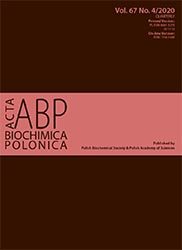Comparing the effects of different exogenous hormone combinations on seed-derived callus induction in Nicotiana tabacum
Abstract
Callus from Nicotiana tabacum is used as a model in plant developmental research. We tested several phytohormone (Indoleacetic acid – IAA; 2,4-Dichlorophenoxyacetic acid – 2,4-D; kinetin – KIN; 6-Benzylaminopurine – BAP) combinations to compare different approaches to callus induction directly from the seeds of Nicotiana tabacum. Callus formation was observed up to 4 weeks after sowing and the most effective were 0.5 mg/L of 2,4-D with 0.25 mg/L of BAP and 2 mg/L 2,4-D with 1 mg/L of BAP. The calli were green, photosynthetically active and after 6 weeks of growth, no stress symptoms (estimated on the basis of fluorescence of chlorophyll a in photosystem II) were noticed.
Acta Biochimica Polonica is an OpenAccess quarterly and publishes four issues a year. All contents are distributed under the Creative Commons Attribution-ShareAlike 4.0 International (CC BY 4.0) license. Everybody may use the content following terms: Attribution — You must give appropriate credit, provide a link to the license, and indicate if changes were made. You may do so in any reasonable manner, but not in any way that suggests the licensor endorses you or your use.
Copyright for all published papers © stays with the authors.
Copyright for the journal: © Polish Biochemical Society.


